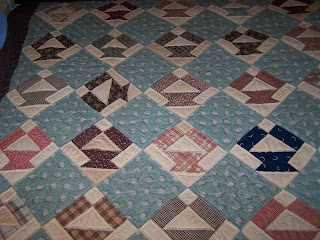 |
| Kimberley Mistique quilt by Gloria Loughman of Australia |
There once was a time when I thought life progressed in a linear fashion. Birth was of course the starting point, ending with the inevitable death. Between those points, life threaded its way through major passages -- turning sixteen, 21, love, marriage, baby carriage... That's as far as I could see or wanted to see my timeline progress at that point of my life. Pretty clear cut journey.
I certainly was naive!
No one told me that once you achieved 21 -- yes, you achieve the age of adulthood-- but then again the progression doesn't stop at the mountaintop but proceeds to 22 and 32 and 42 and 52 and people expect someone of this certain age to act appropriately. And I was, if nothing else, raised to please others and meet their expectations.
It has taken me several decades to realize that the only expectations I should consider seriously are my own. So, here I am, not having achieved any of the goals other than traditional (wife, mother....) and wondering why I wasted so much time trying to be what others wanted me to be. I think I was trying to achieve that straight life line with as few deviations, risks, pitfalls as possible. Yet by doing so I also avoided the joys and celebrations and serendipitious surprises.
As a quilt lover, I think a map of even my relatively uneventful life would make for an interesting quilt -- maybe similar to those made by Gloria Loughman of Clffton Springs in Victoria, Australia. You may be familiar with her Kimberley Mystique which won Best of Show in her state exhibition and also the prestigious Australian National Quilt Award. I can dream that my little quilt could look like hers!
My husband and I have moved so frequently that I'm no longer sure what my home landscape looks like. If it could look like that depicted in Kimberley Mystique, I'd be a happy woman.
 |
| Quilted Symphony by Gloria Loughman Published by C&T Publishing March 2010; $29.95 |
Line. Shape. Color. Value. Texture. Harmony. Repetition. Contrast. Balance. Focal Point. Direction. Movement. All are part of designing an abstract quilt and when you think about it, part of a life well lived. I see my sedate little landscape transforming. The flat lands begin to roll. The houses tip, the sandhill cranes grow bigger and my house smaller. The landscaped lawns converge and snake around the houses in a vibrant patchwork. Sidewalks turn into trails featuring the flying geese pattern and round faces appear helter skelter.
In Gloria's book, which she says is for those who "...would like to experiment with patterns and colors and want to take that next step but don't know where to start, then this book is for you," she suggests sources of inspiration. And she begins with a doodle. When approached in this manner, there is an element of Zentangle in her quilts. Not that she necessarily uses that technique, but her doodles take on a zen like quality in their repetition and harmony. She transforms three simple leaf shapes into a jungle of design and texture with a few lines and circles. I also like her suggestion to take a photograph and then use a portion of it as inspiration for an abstract quilt.
Looking at her examples and photos of inspiration, it wasn't long before I would look at things as shapes -- my monitor is a rectangle. The lamp shade a triangle, my book shelves are a collection of varying sizes of rectangles.
Gloria devotes a whole chapter to color with the ever present color wheel for these types of discussions. But she also concentrates on intensity and hue, value and color schemes that go beyond monochromatic and complimentary. She brings out triadic and tetrad color schemes. What!?
She moves on past drawing the design to actually constructing what you've created. Prepare the base, make segment patterns, decorate the segments, invisible fused applique and so on and so on. In her abstract designs appear familiar traditional patterns -- flying geese for example or snail's trail. diamonds and pyramids, even my favorite lowly nine patch.
Beading and braids give way to painting and sun printing and Gloria takes readers into satin stitches and thread choices, even bobbin tension and right into free motion quilting and how to find your speed. Decorative stitches are even addressed. Foundation piecing is a must as well.
Quilters know every quilt has a border, whether you do art quilts or traditional the edges border on to the rest of the world and how you finish them can make as much of a statement as the quilt itself. Gloria offers various suggestions.
Then she also offers several projects to try out all of the things taught in the 103 page book and she includes a students' gallery to give you hope and inspiration. Included are full size patterns to use in the projects.
After a quick trip through her book, I will be returning and see if I can't turn my life's journey into a visual symphony of fabric, texture and design worthy of her masterful instructions.
CT published "Quilted Symphony," released in 2010. Cost is around $30. For anyone beginning the journey into abstract quilts, or stepping away from prepared patterns and finding your own voice, this book may ease you into this new fabric landscape of symbolism, shape and design. If nothing else her own creations will give you inspiration. I'm looking at leaves in a whole new way.
I'm also preparing to create a more exciting life journey so that future quilts have a more interesting terraine to replicate! It is time to embrace whatever opportunities and challenges come my way. Maybe the best way to depict my life to this point would be ostrich with head firmly planted in the sand. But I'm shaking sand from my eyes and looking around in wonder.














